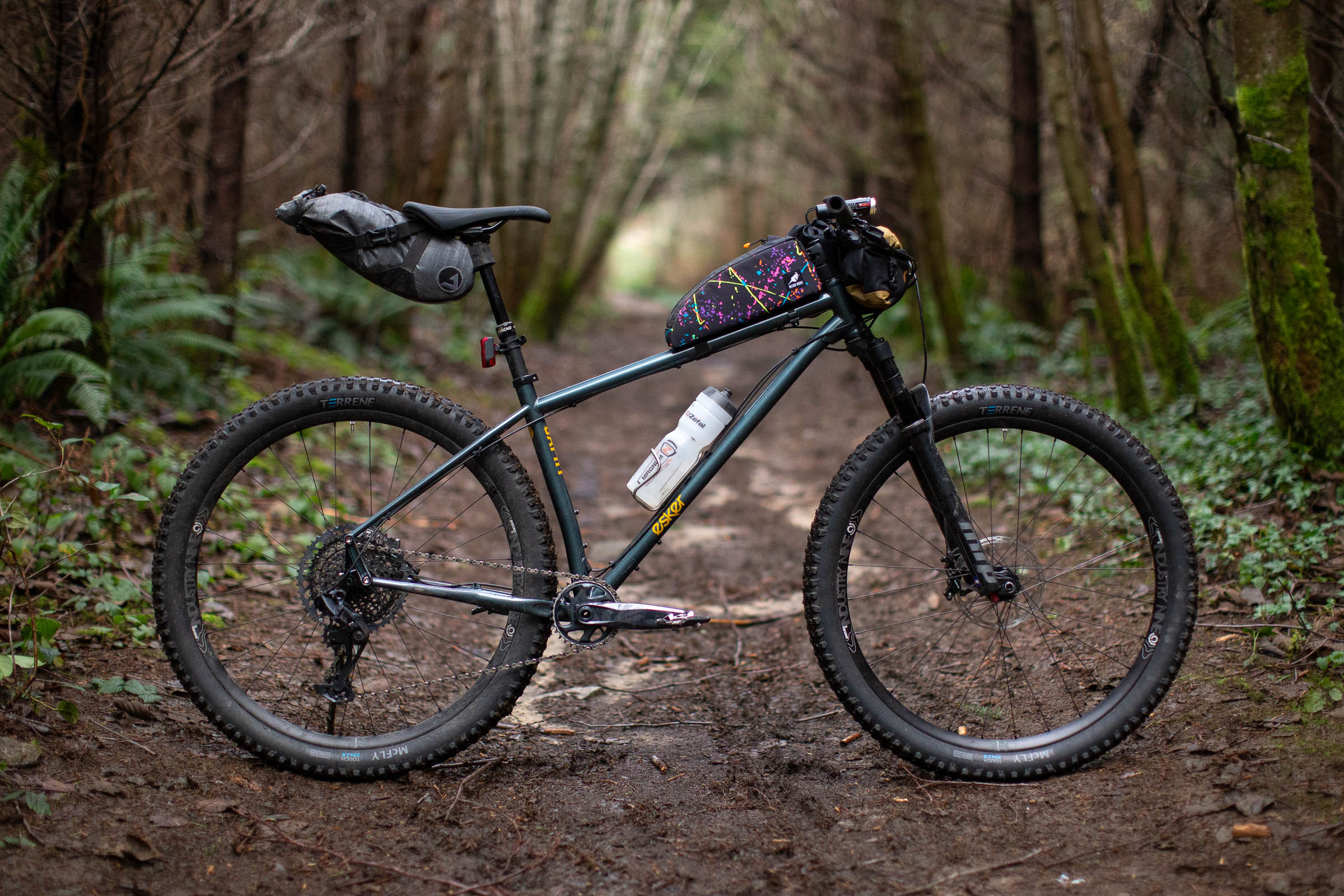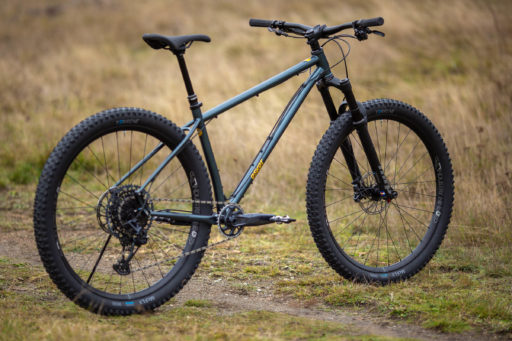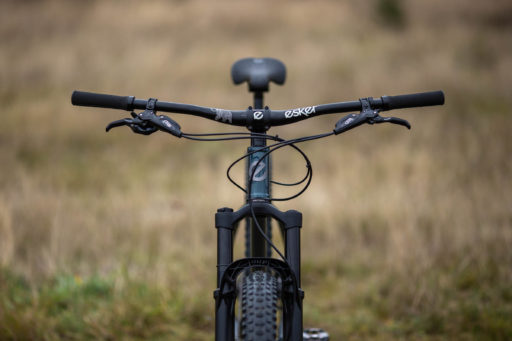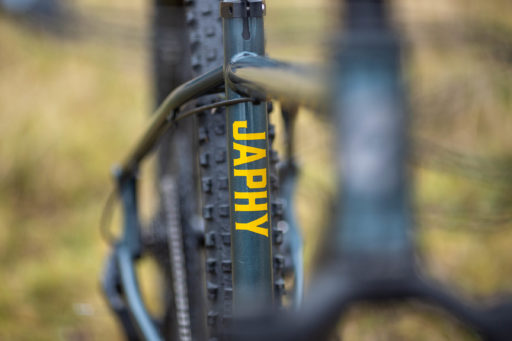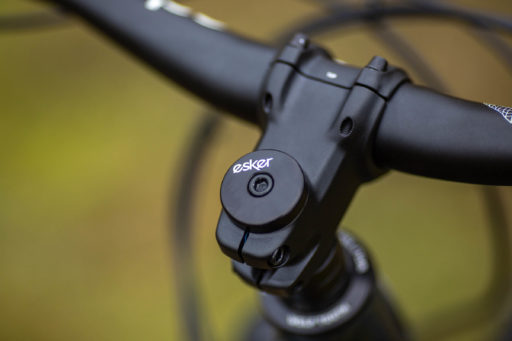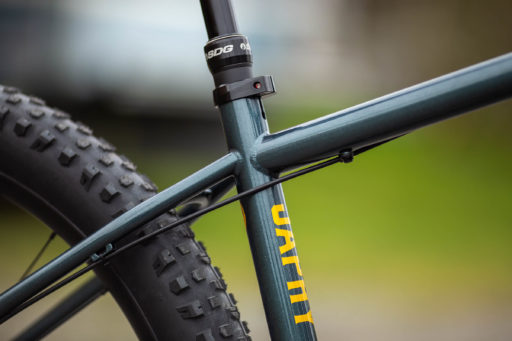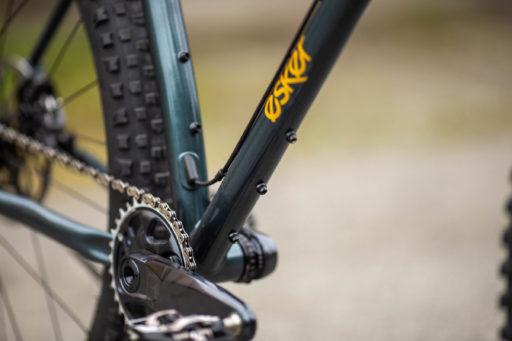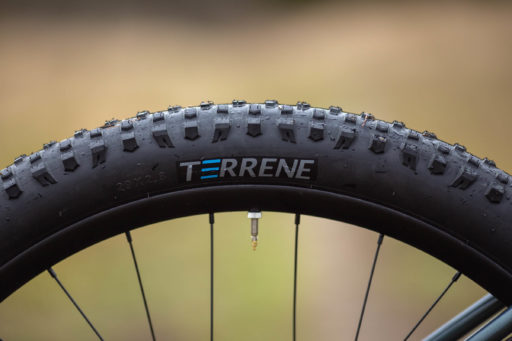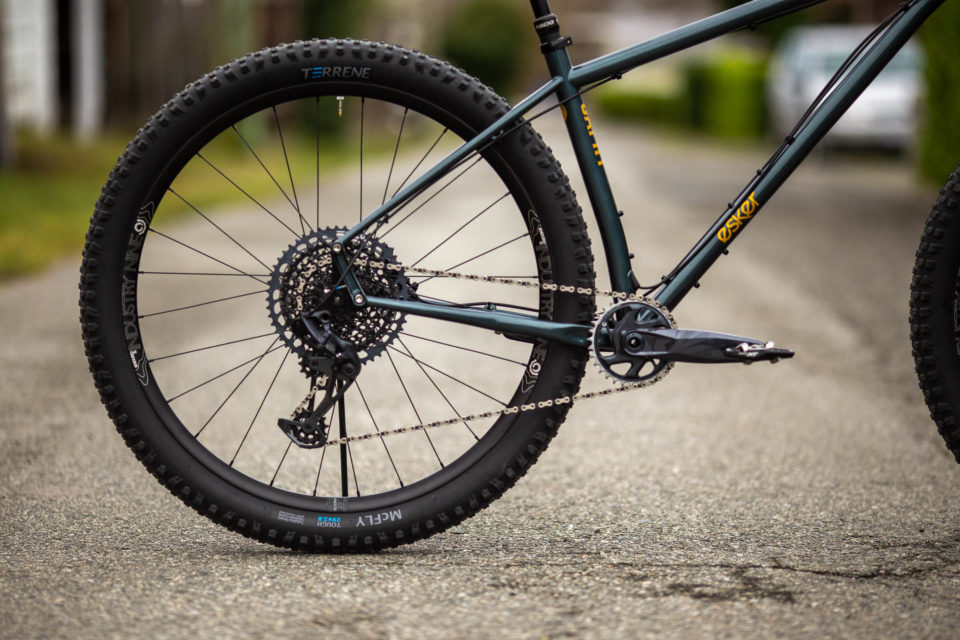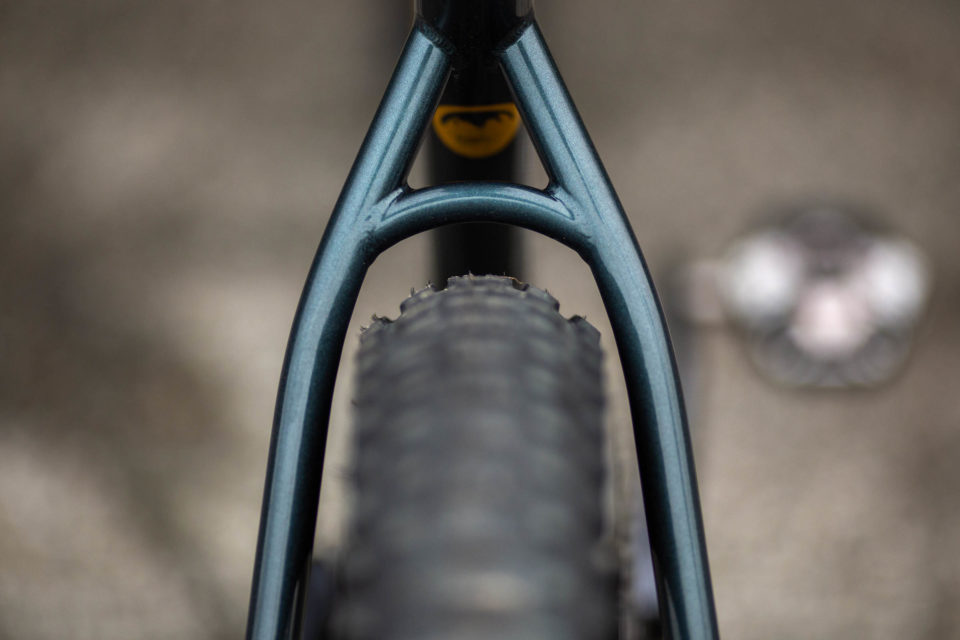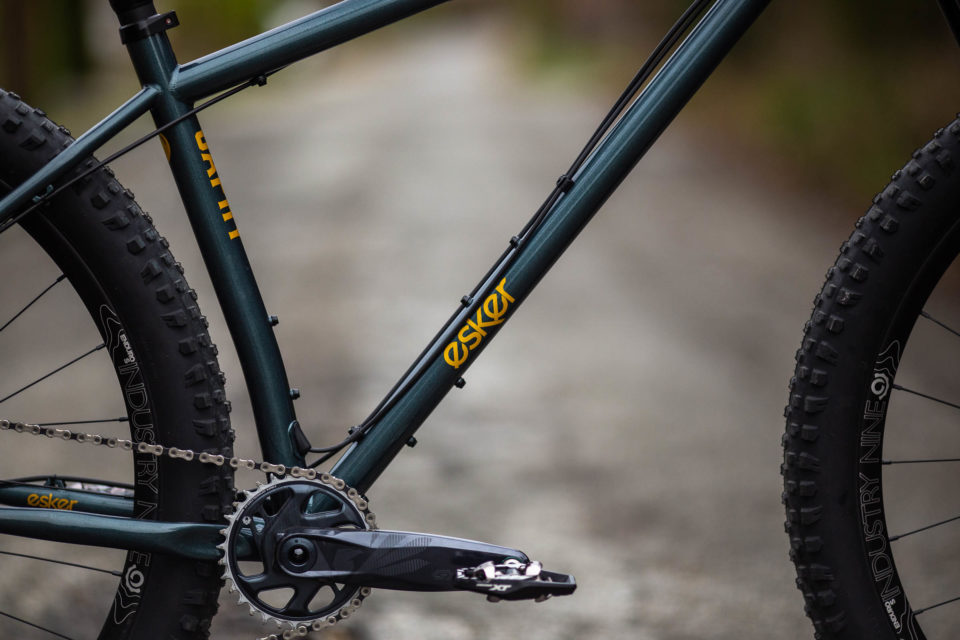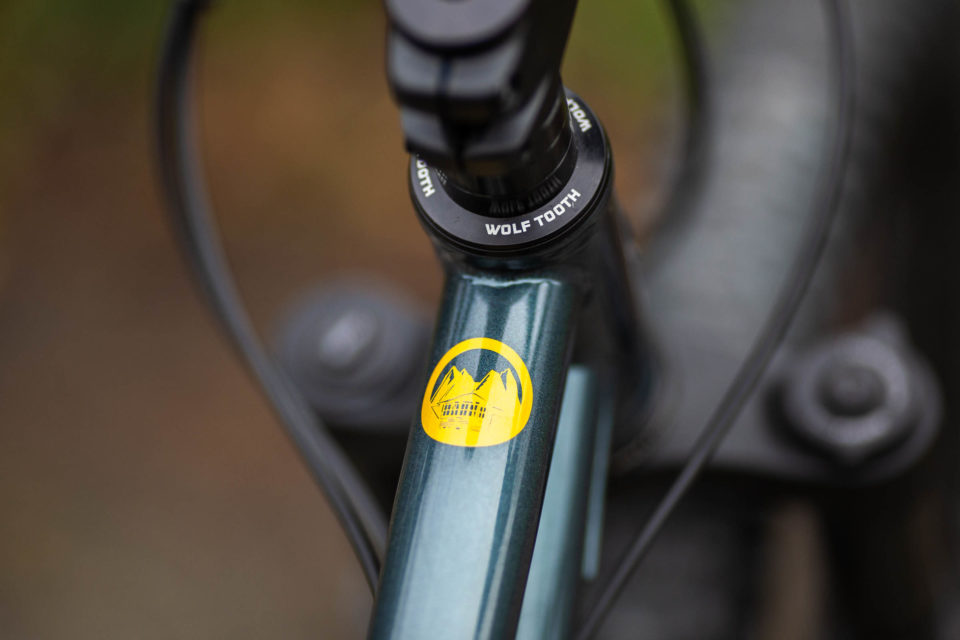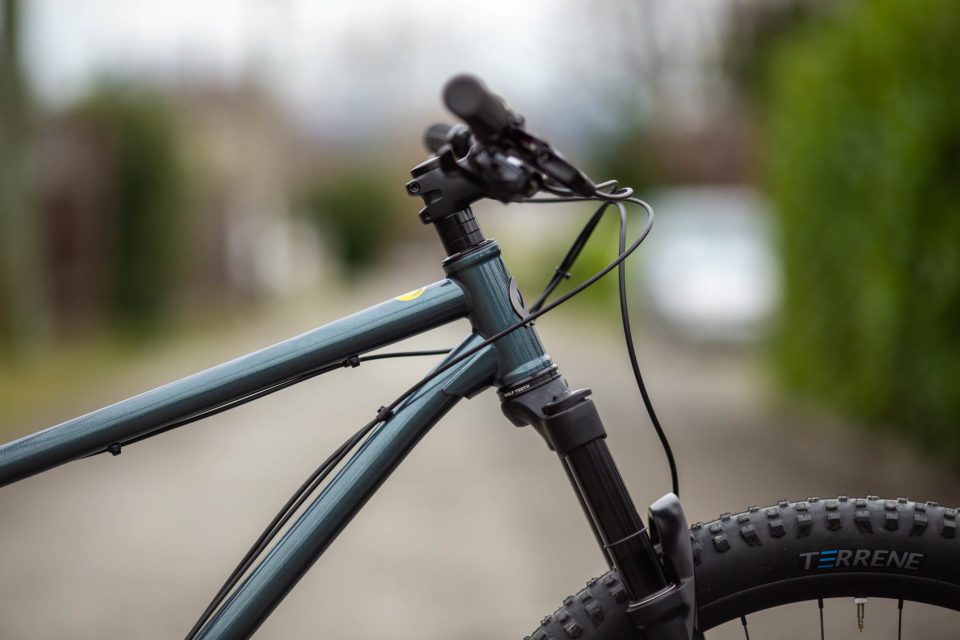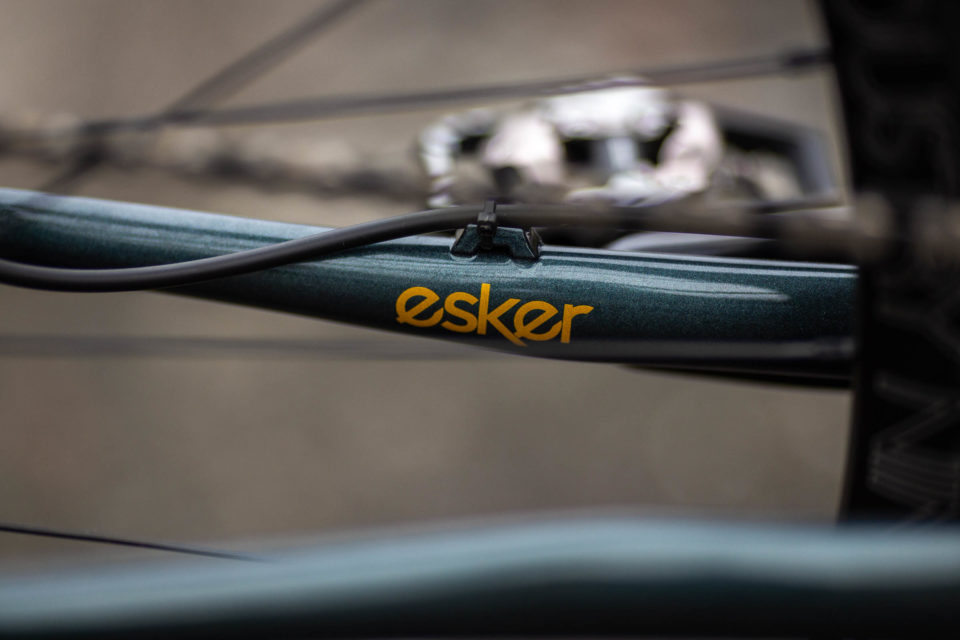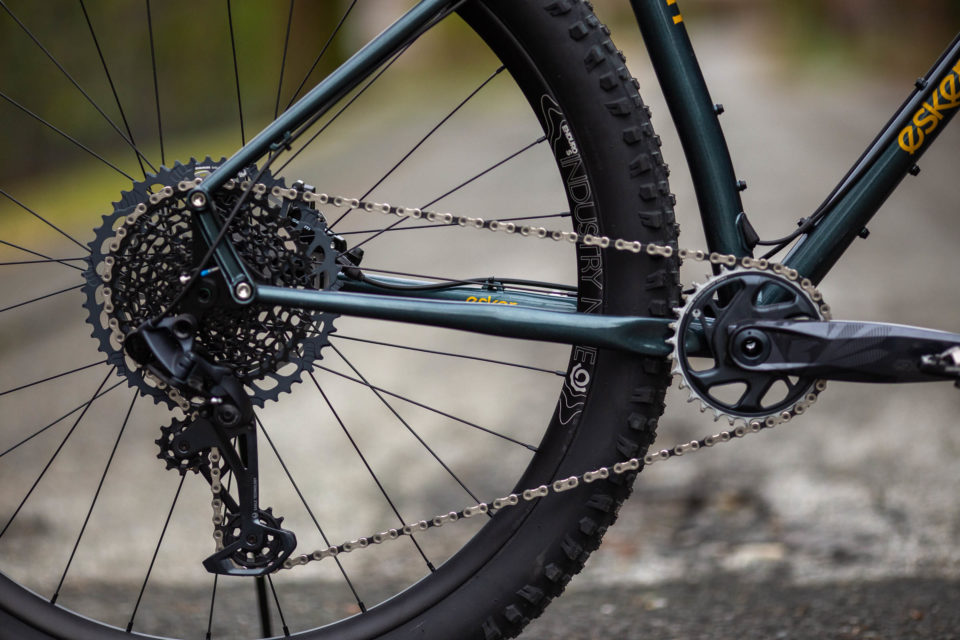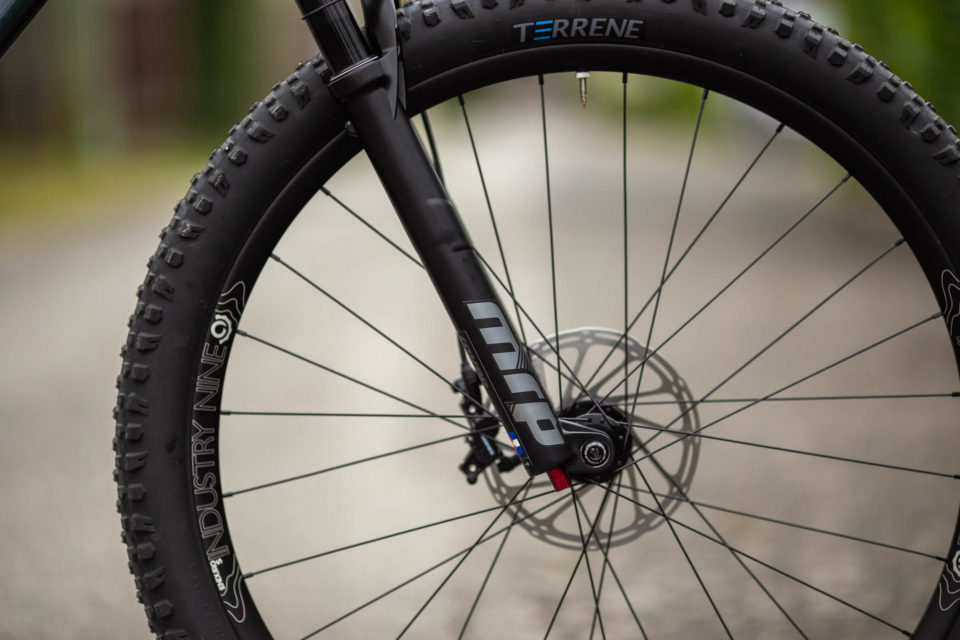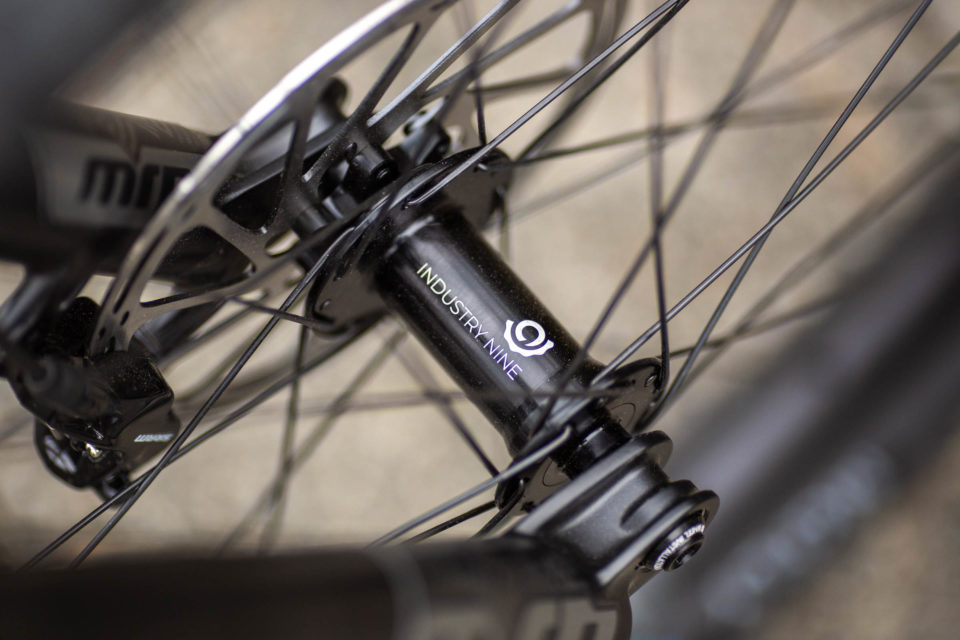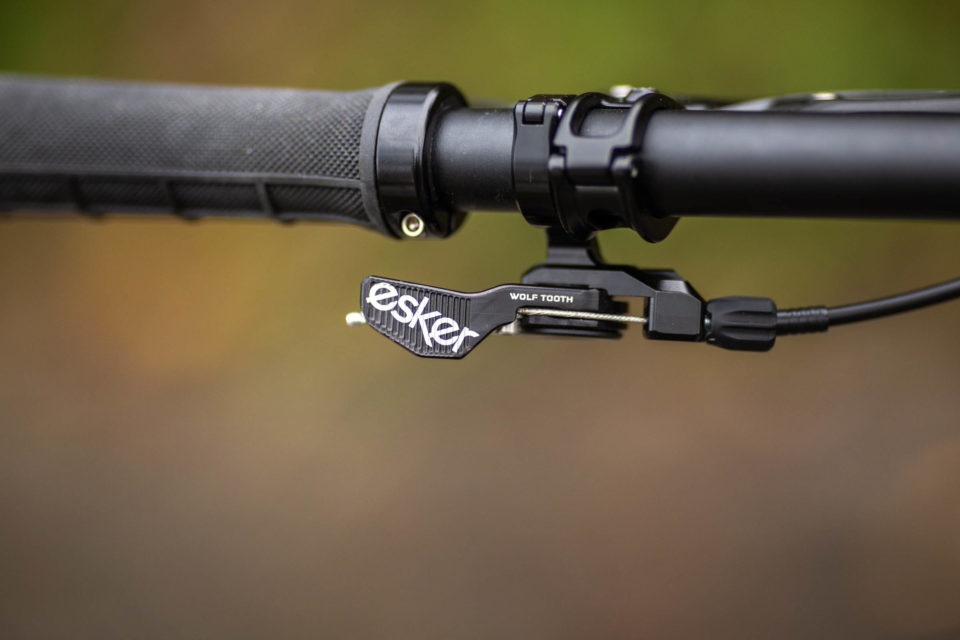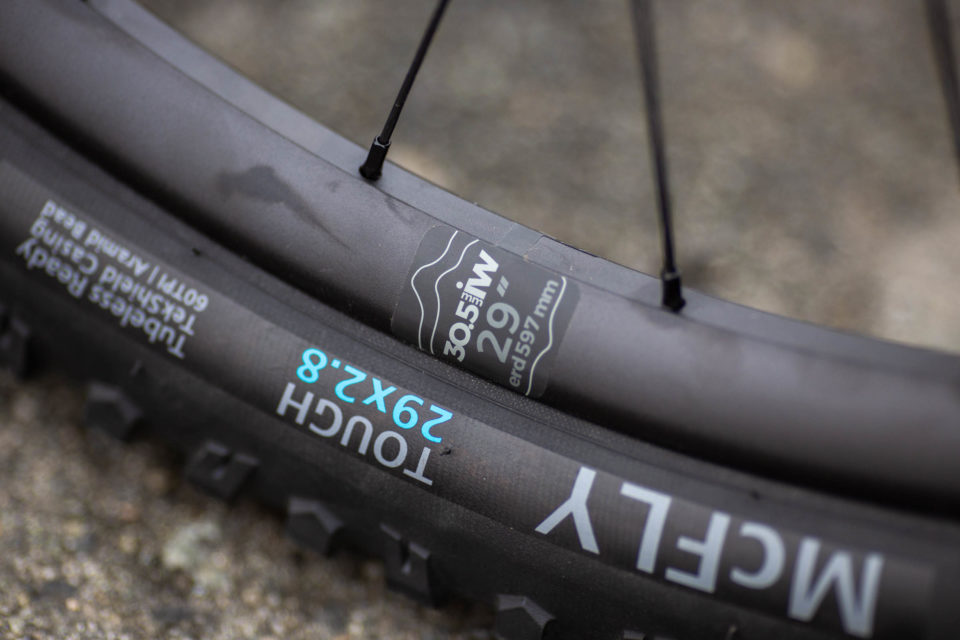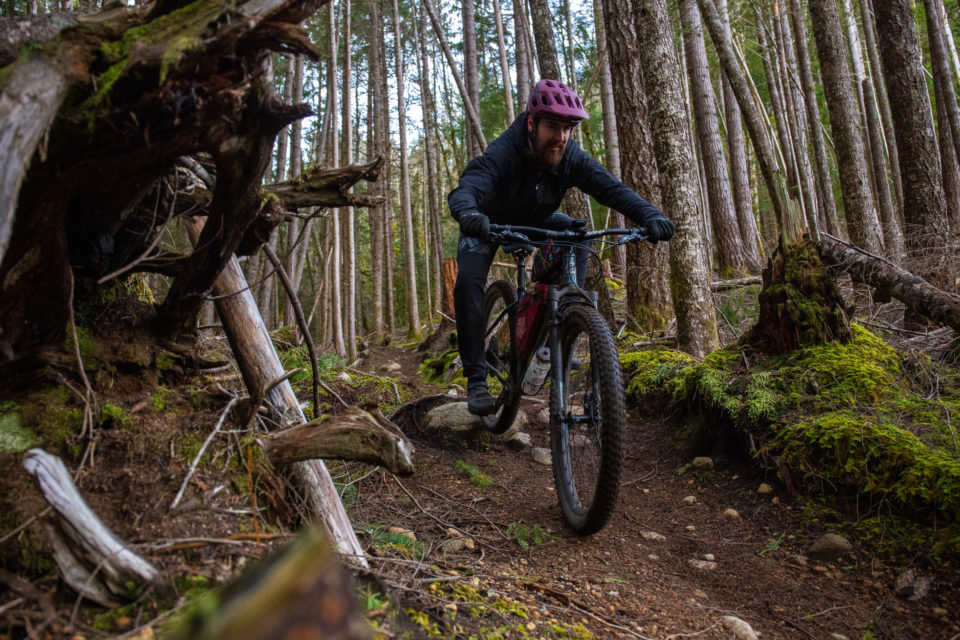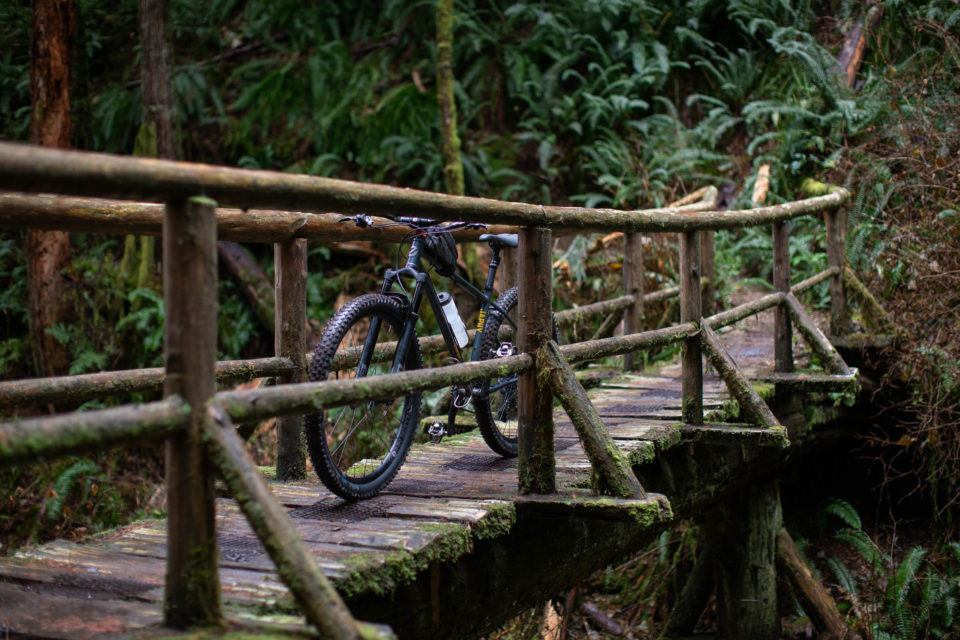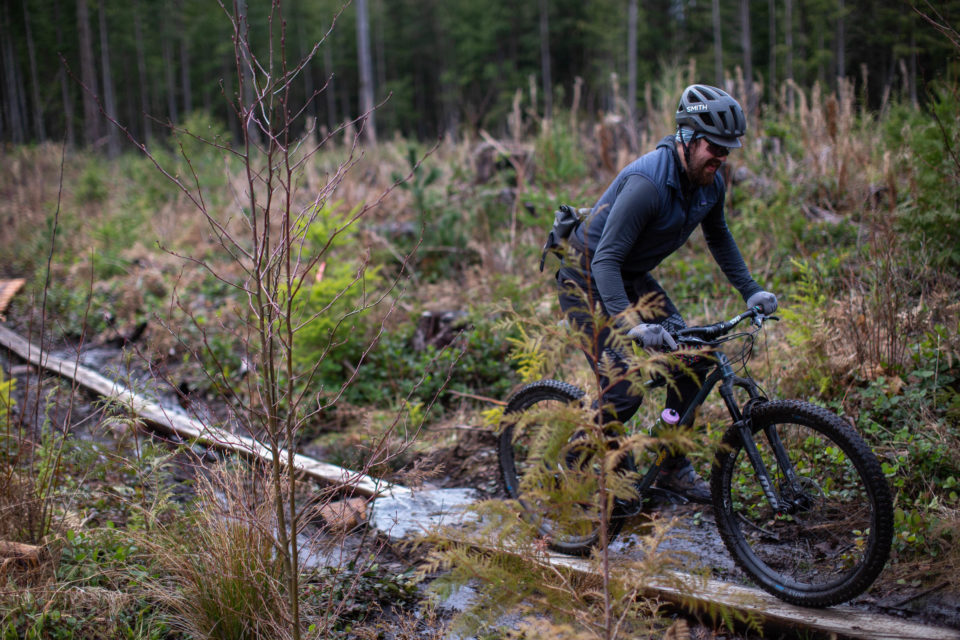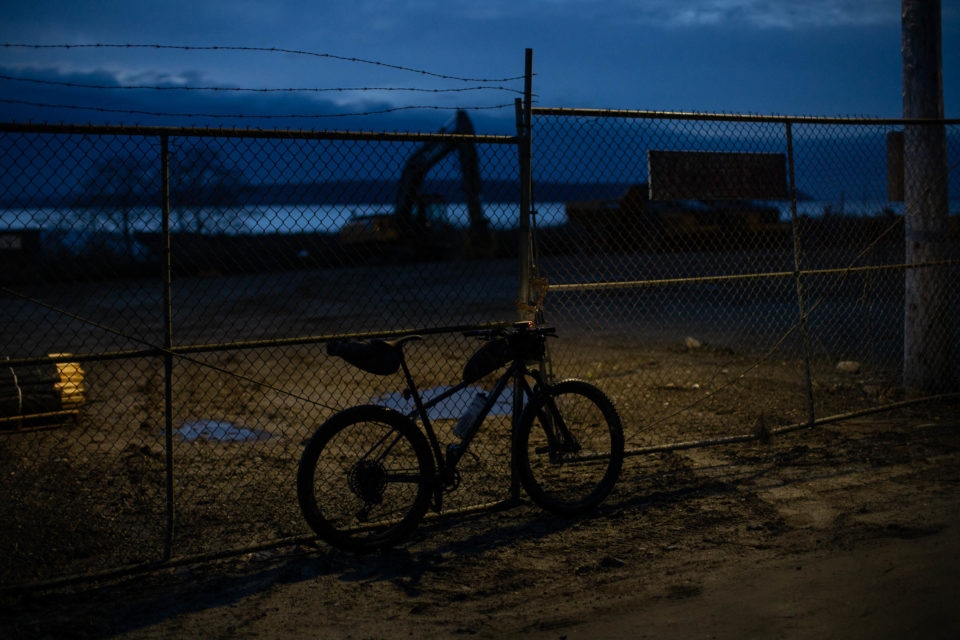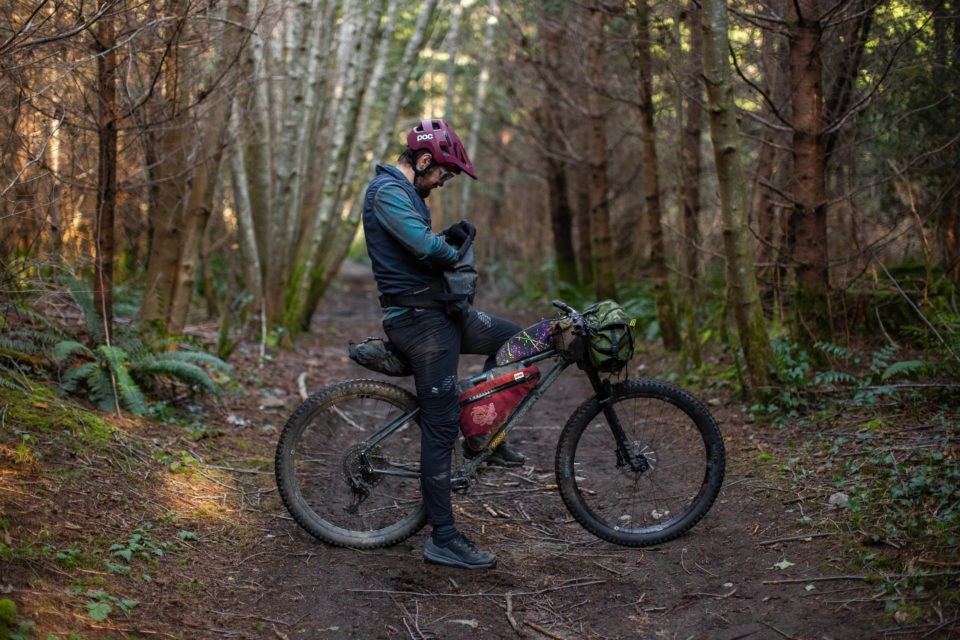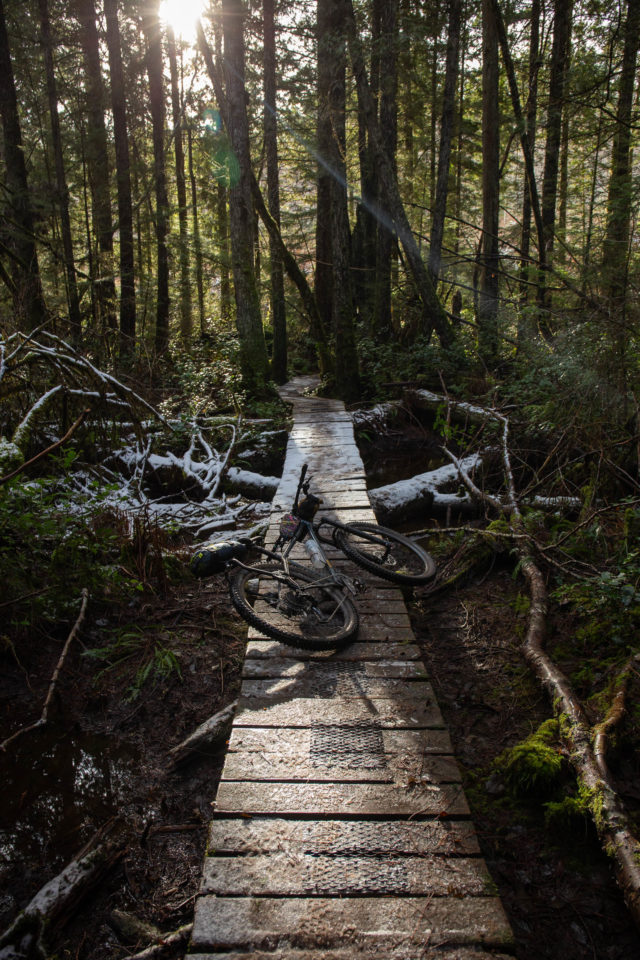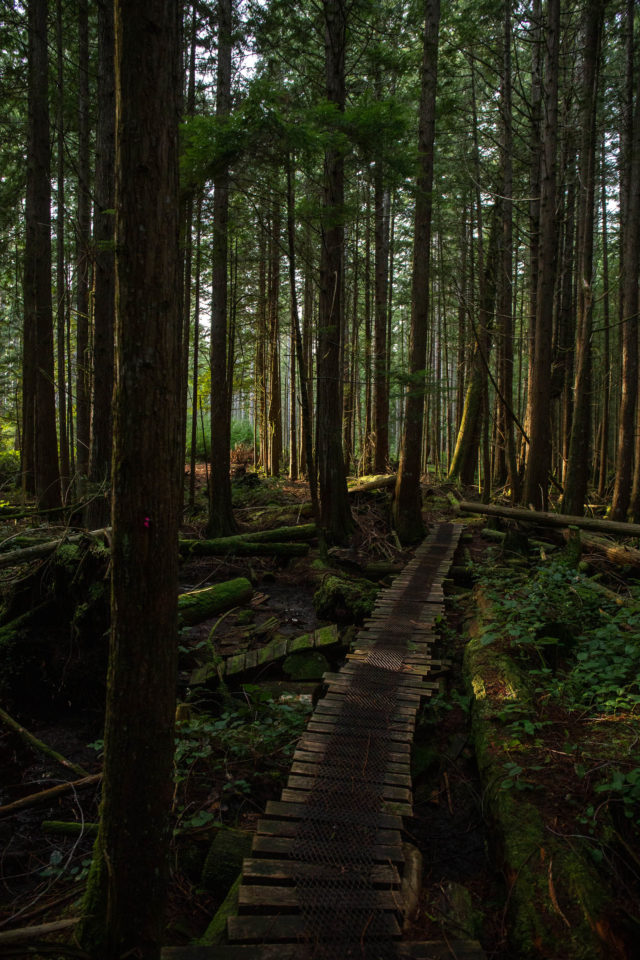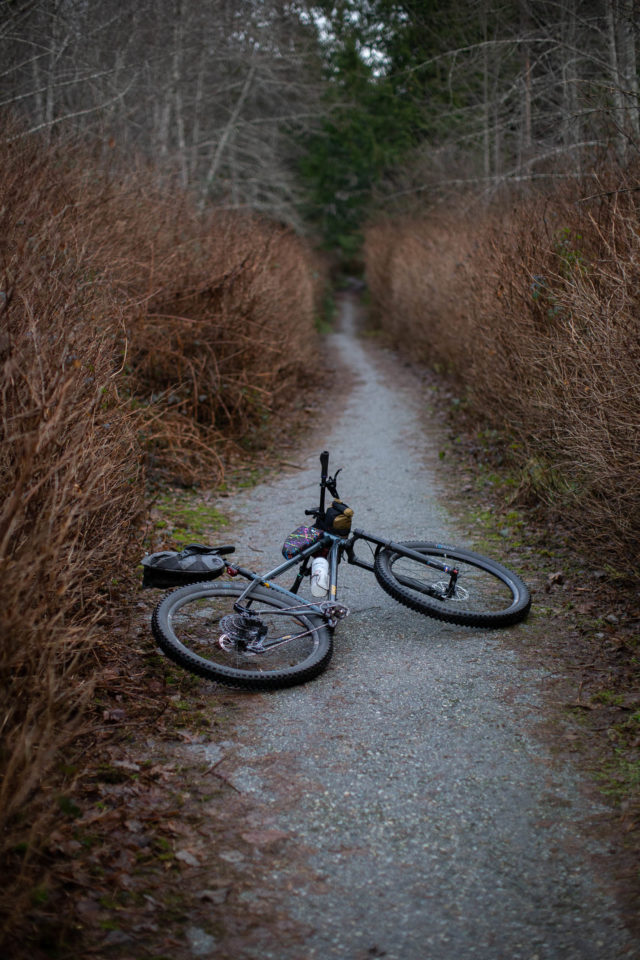Esker Japhy Review: Next-Gen Steel Hardtail
Share This
Released as a 29” alternative to the incredibly versatile Hayduke, the Esker Japhy is a chromoly steel hardtail with 29+ tires, a 120mm travel fork, and three value-packed builds to choose from. We’ve been testing the mid-range Japhy J2 for the last few months to find out what it’s capable of. Find the full review here…
Esker Cycles has been busy over the last few years. After a complete rebrand from their former identity, Advocate Cycles, the company launched not one but two new full-suspension mountain bikes, and updated their popular steel hardtail, the Hayduke. After all that, we were curious if Esker would advance the hardtail lineup or just keep the Hayduke in the mix for posterity.
We got our answer in November 2020, when Esker updated the Hayduke with a 140mm travel fork and dedicated 27.5” build kits. A few days later, they announced the Japhy, filling the 29” gap with a new longer-lower-slacker model to fit in with the latest trail bike trend. However, with three complete builds to choose from, all with a 120mm travel fork, adjustable rocker dropouts, and 29 x 2.8” tires, the Japhy seemed to have the bones for what we consider the perfect bikepacking and backcountry singletrack rig, at least on paper. Coming from a string of relatively conservtive hardtails, the Japhy was perhaps the most modern hardtail I’ve tried to date. I wondered how its progressive geometry would stack up against my beloved Why S7 and the recently reviewed 2020 Salsa Timberjack, both slightly more old-school by comparison.
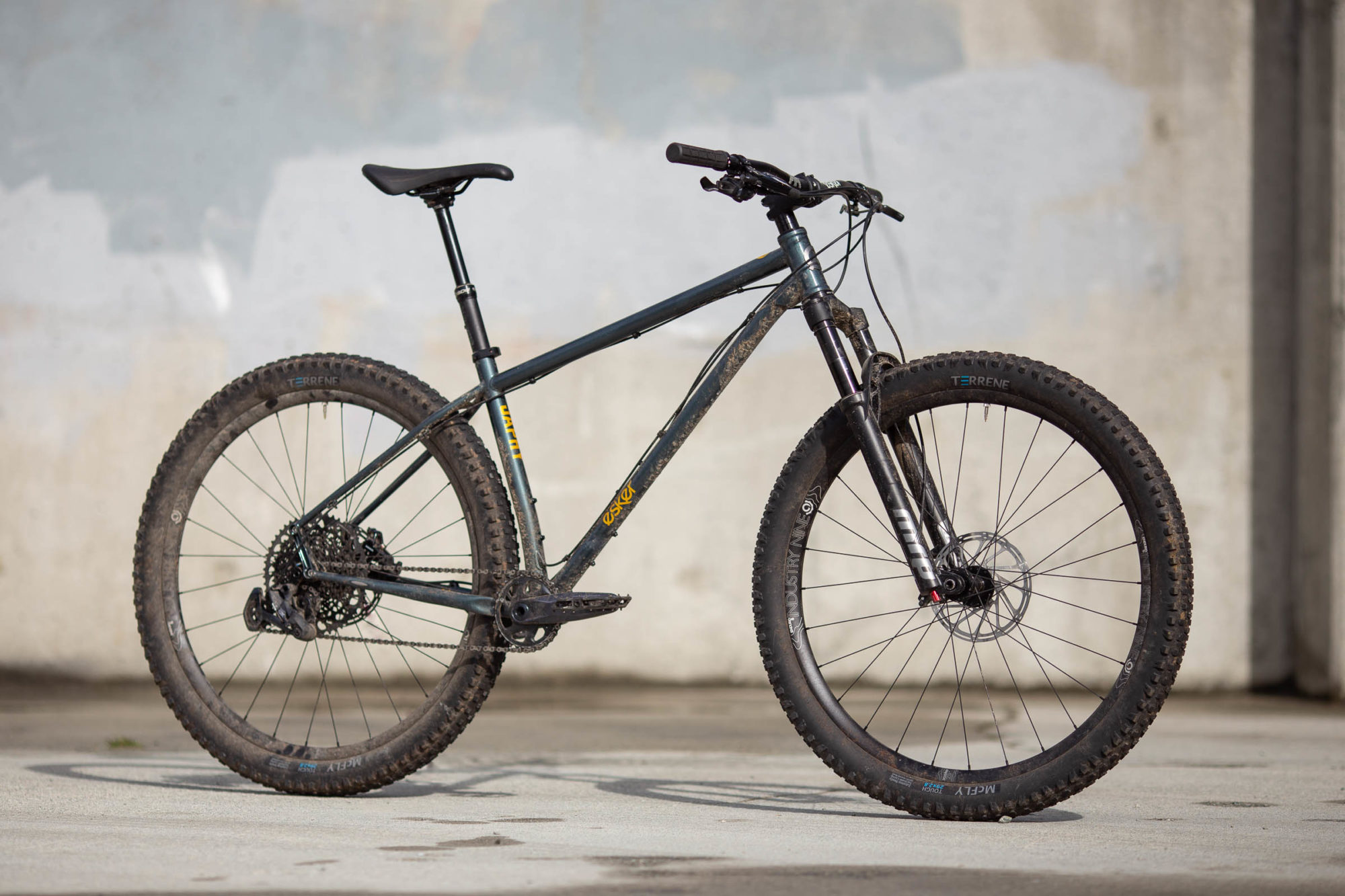
So, why introduce an entirely new model when the Hayduke can already swap between 29” and 27.5” wheels? For starters, it can’t clear 29 x 2.8” tires. The Hayduke’s geometry is also a little more reserved when compared to the Japhy—think Surly Karate Monkey, Niner SIR 9, or the other two bikes I mentioned above. The Japhy is a completely different bike, more comparable to the Kona Honzo ST (with bigger tires), Jamis Dragon, or Nordest Sardinha. The Japhy is longer, lower, and more slack than the Hayduke. Its length can be attributed to its long front end and 66° head tube angle. It also has a 15mm increase in bottom bracket drop and a 34mm lower standover height (size large), making room for a longer travel dropper post.
- Highlights (Large)
- Angles: 66° Headtube, 75° Seattube
- Chainstay: 425-437mm
- Bottom Bracket: 73mm Threaded
- Hub specs: 15 X 110mm (front); 12 X 148mm (rear)
- Seatpost Diameter: 31.6mm
- Max Tire Size: 29 x 2.8″
Before I dive into my review, it’s worth highlighting that I’ve spent most of my time riding mountain bikes with more conservative geometries and traditional angles. Over the last few years, I’ve logged thousands of miles on my Why S7, and I believe that has some influence on how I dissected the Japhy. It’s wild to think that at the time the S7 was conceived, it too was considered to be a progressive, dare I say aggressive, hardtail. While both the S7 and Japhy can be ridden in all the same places, they’re worlds apart when you really dig into it.
Long, Low, and Planted
The Japhy’s geometry was something new for me. Although its angles might not be quite as extreme as other steel hardtails, such as the Kona Honzo ESD, Norco Torrent, or any of Chromag’s steel hardtails, it’s much more progressive than what I’m used to. The Japhy maintains fairly short chainstays, from 425-437mm on all sizes, but its long front end and 66° head tube angle result in a generous 1195mm wheelbase on the size large. Combined with a long reach, stubby 50mm stem, relatively low bottom bracket, and wide 780mm bars, those angles and numbers make it clear that Esker is aiming for something more progressive than the Hayduke, or as they claim, something for “everything from the backyard to the backcountry.”
For the most part, I think Esker’s claims about the Japhy hold true in the real world. Despite its weight, the short chainstays kept the rear end from feeling sluggish and it was easy to drop the saddle and get my weight back on steep descents. Pair that with a long front end and big tires, and it can only be described as a steel monster truck. While riding slowly, the big tires and delightfully plush MRP Raven fork (more on that below) help keep things from bouncing around too much. However, when compared to the Why S7’s more conservative angles, it didn’t feel quite as at home navigating slow-speed technical trails.

The Japhy really comes alive on rough trails and chunky roads. While zipping along at speed, the Japhy skims effortlessly through rock gardens, roots, and rutted-out trails. Its slackish headtube angle and low bottom bracket made for great cornering and a flowy feel that was consistent on steep terrain and even the slightest of downhill gradients. Although I didn’t get a chance to venture up into any ridgeline singletrack, it’s the exact sort of bike I’d want to bring on a bikepacking trip into the South Chilcotins or other big and bumpy terrain. At low speeds, my experience was vastly different from my time spent riding hardtails like the Why S7 and Salsa Timberjack. While climbing, the big tires, long front end, and 66° headtube angle gave it a tendency to venture off course if I wasn’t fully invested in controlling it, and the sheer length of the bike isn’t ideal for tight, awkward switchbacks or navigating slow-speed technical climbs. That said, the Japhy was always comfortable and stable, which are great qualities for venturing out into remote places.
Frame Details & Observations
All of the welds, finishings, and details on the Japhy’s frame are top notch. Plus, the “dawn” paint job on my loaner bike has a unique look, especially with the hint of sparkle that glimmers in the sun. The frame is made from externally tapered, seamless, quadruple butted, heat treated 4130 Chromoly steel, and the tubing is specific to each size, which in theory should keep the ride quality and weight consistent across the size range. The Japhy and Hayduke share Esker’s modular Portage dropout system, boost hub spacing, and frame specs that include a threaded bottom bracket, internal dropper post routing, and externally routed shifting cables and brake hoses. The majority of the Japhy’s cables are bolted directly to the frame’s braze-ons, which can be mixed and matched easily, depending on drivetrain choice or to achieve the perfect cable routing. These small details all add up to a modern steel hardtail that’s a step above your run-of-the-mill frameset, without a staggeringly high price tag to match.
When the Japhy was first announced, a lot of people were thrown off by the max 29 x 2.8” tire clearance. Truth be told, this one of the design choices that has me a little confused, too. Mainly because there aren’t many 29 x 2.8” tires to choose from. All of the complete builds come with 29 x 2.8” Terrene McFly tires, which fit fine in all positions in the sliding dropouts, except when slammed in the shortest position, where the wheel won’t even spin. I tested a knobby 29 x 2.4” (Teravail Kessel on 29mm internal width rim), which had plenty of room, even with the dropouts in the shortest position. I’ve heard some true 29 x 3.0” tires will fit with the dropouts backed all the way out, but can’t confirm.
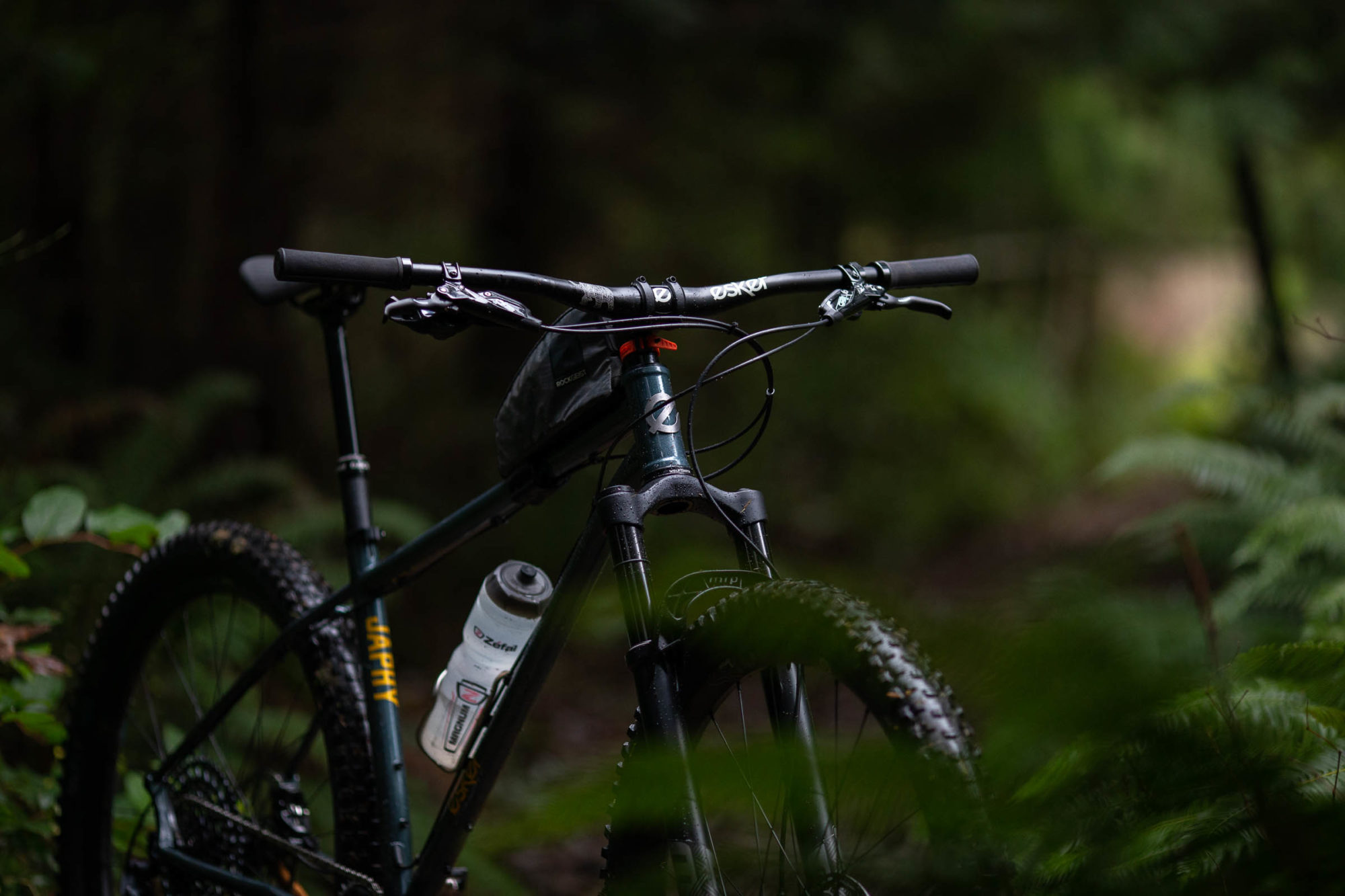
It’s worth noting that Esker decided to go with a crimped chainstay, and perhaps if they employed a half-yoke stay design it would have helped increase tire clearance to a true 29+. That, or maybe the Japhy should have been optimized for 29 x 2.6” tires, as there are more options, clearance would be less of an issue, and they’re what I consider a sweet spot for a 29” bikepacking rig.
Esker Japhy J2 Build Kit
Esker took a slightly atypical approach to the three Japhy build kits, each of which seems well thought out. The mid-range J2 build I tested retails for $3,300 USD and offers a thoughtful blend of high-end and mid-range components. The $2,300 J1 build also offers great value in all the right places and shouldn’t be overlooked. Although there’s little similarity among the builds, each is based around a 120mm travel fork, 29 x 2.8″ tires, SDG Tellis dropper post, four-piston hydraulic brakes, Wolf Tooth Components headset, and a 12-speed drivetrain. Complete bikes are built to order and shipped directly from Esker headquarters in Montana.
The J2 build comes with an MRP Raven fork, SRAM G2 RS brakes, Industry Nine 1/1 Enduro S wheels, SRAM GX 12-speed drivetrain, and a custom Esker-branded Wolf Tooth Components dropper lever. The nice thing about buying from a smaller brand like Esker is that the different components are carefully selected and leave little to be desired. Small touches such as the fantastic Wolf Tooth dropper lever and Industry Nine wheels are great inclusions. The entire J2 build screams high-end performance and reliability, and I had few complaints about any of it during my time with the Japhy.
Build Kit
- Frame Custom Drawn, Quadruple Butted, 4130 Chromoly Steel
- Color Dawn
- Sizes S, M, L, XL
- Fork MRP Raven 120mm
- Headset Wolf Tooth Components, ZS44 / EC44
- Bottom Bracket SRAM DUB 73mm Threaded
- Crankset SRAM GX Eagle, 32T
- Cassette SRAM GX 10-52T
- Rear Derailleur SRAM GX, 12-speed
- Shifter SRAM GX Eagle
- Chain SRAM GX 12-Speed
- Brakes SRAM G2 RS, Hydraulic
- Rotors SRAM Centerline 180mm
- Front Hub Industry Nine 1/1, 15x110mm
- Rear Hub Industry Nine 1/1, 12x148mm
- Rims Industry Nine Enduro S i30.5mm
- Spokes J-Bend
- Front Tire Terrene McFly 29×2.8”
- Rear Tire Terrene McFly 29×2.8”
- Handlebar Esker Epoch Alloy, 780mm
- Stem Esker Epoch Alloy, 35 x 50mm
- Seatpost SDG Tellis Dropper Post, 150mm
- Dropper Lever Wolf Tooth Remote
- Saddle SDG Bel-Air 2
Even on such an impressive build, the MRP Raven fork was a standout component for me. The Raven is MRP’s newest fork. It trickles down several features from their higher-end Ribbon fork but for $200 less. The Raven’s small-bump sensitivity was much more noticeable than that of my Why S7’s Fox 34 Performance, and it helped keep the larger volume 29” tires on the ground and traction at a max. The Raven has two independent air chambers that allow for greater adjustment and it has a coil-like feel through the beginning and end of the stroke that was surprisingly noticeable. It soaks up small rocks and roots without coming close to bottoming out on larger drops and bigger hits.
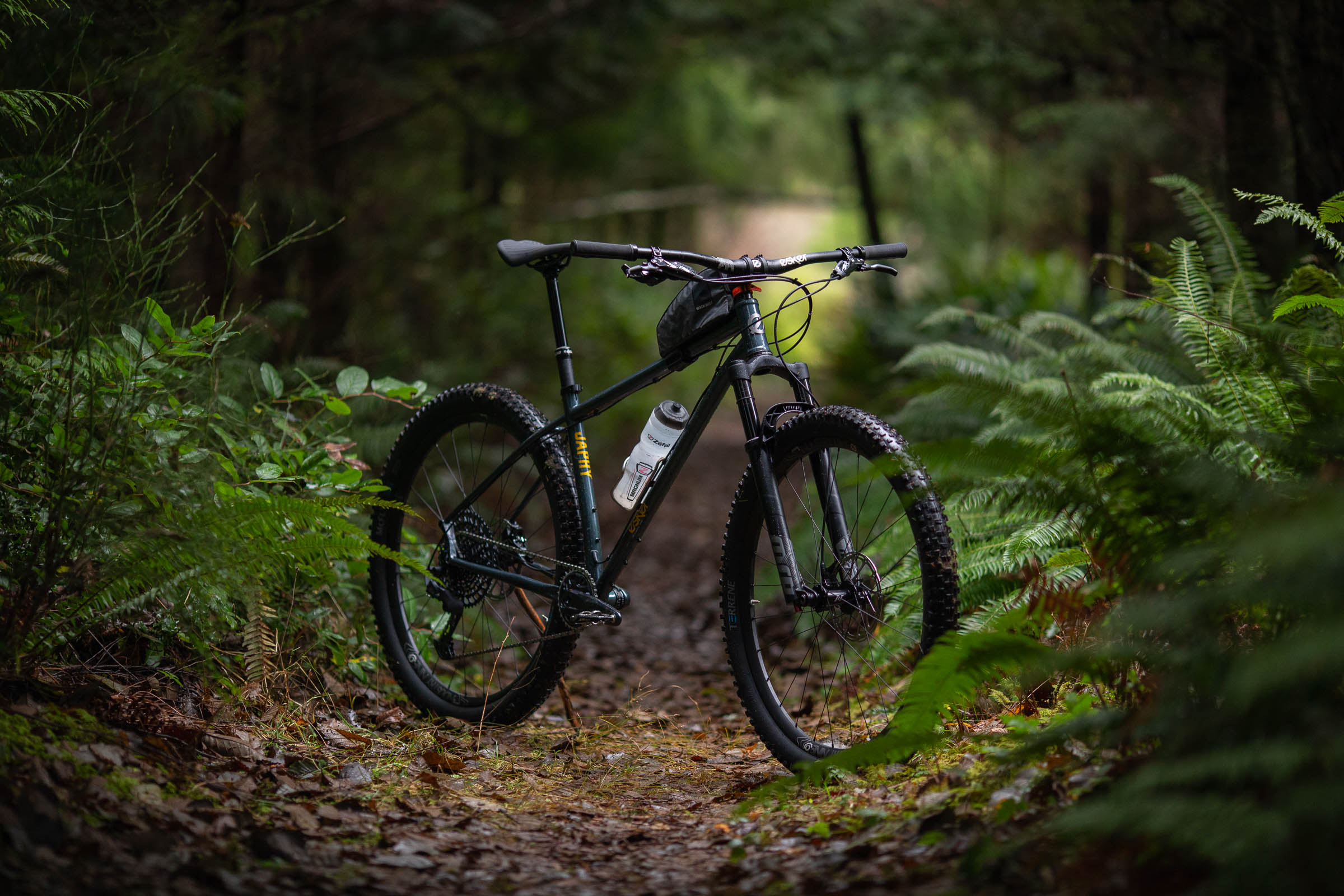
The SRAM GX 12-speed drivetrain functioned flawlessly, though I prefer the slightly clunkier mechanical feel of Shimano shifters. The Wolf Tooth Remote dropper lever is great to see on a stock build, especially when stock dropper post levers aren’t usually anything to get excited about. The four-piston SRAM G2 RS brakes did their job, but the stock organic pads didn’t stand a chance against winter in the Pacific Northwest. I also find SRAM’s brake levers more awkward to work handlebar bags around compared to Shimano’s levers due to the angle of the brake hose.
I’m a big fan of mechanically actuated dropper posts, and the SDG Tellis post performed great during my entire testing period. It was always quick to return and rarely shuttered, even when loaded with a small seat pack. I found the 150mm travel post specced on the size large Japhy far too small for me at 6’1” with a 33” inseam, and it’s even more odd to see the same size specced on the XL. With all of that real estate available, you’d expect to see Esker maxing out that space with an adjustable travel dropper post.
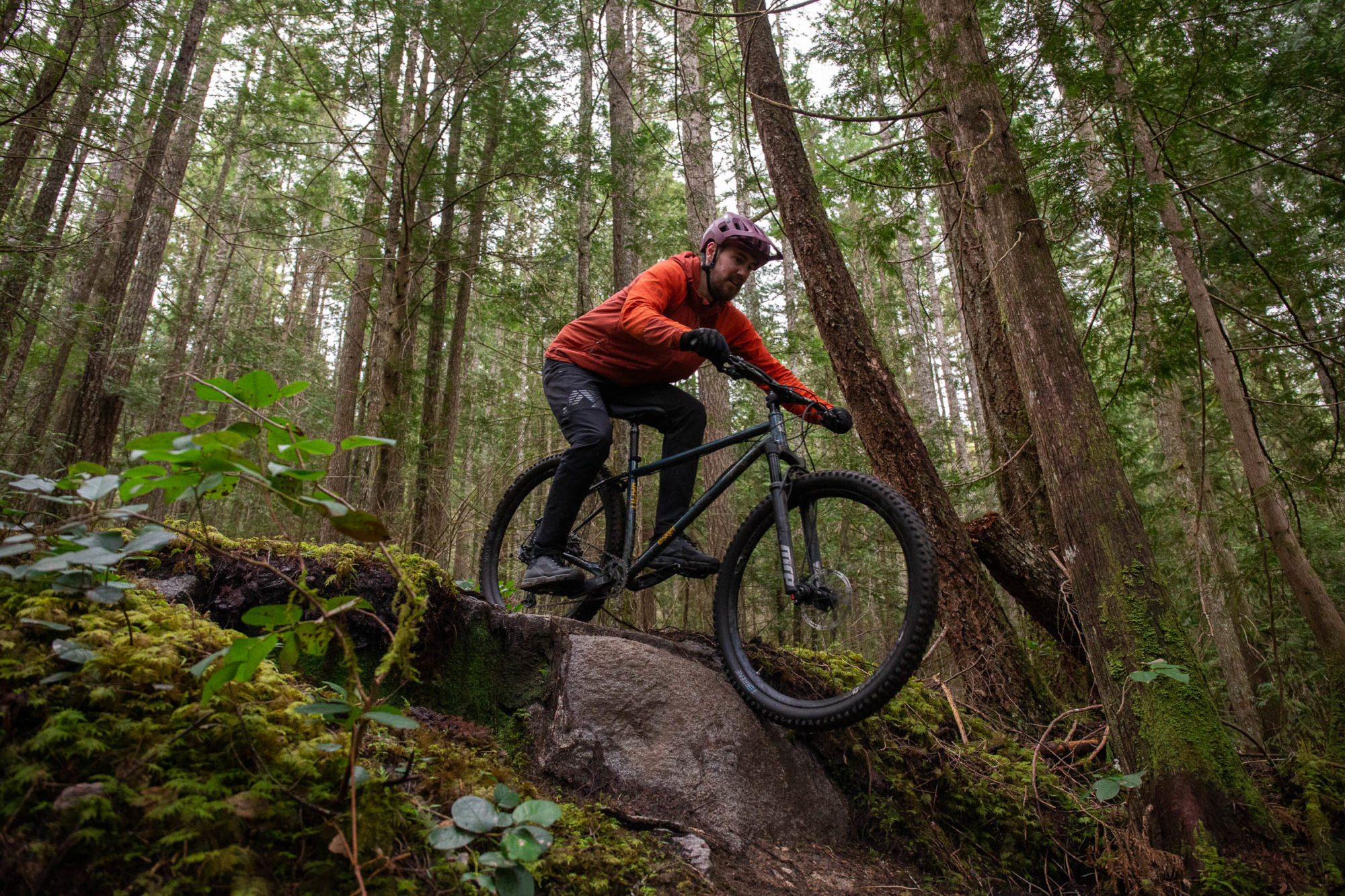
Loading up the Japhy
I’ve logged a lot of miles on the Japhy in the last few months, mostly at least semi-loaded. It’s a heavy bike to begin with, so I was never hesitant to strap a bag on to carry some extra layers or to bring a stove along for the ride. The Japhy handles the extra weight naturally and never felt unbalanced, which I attribute to its long wheelbase, slackish front end, and big tires.
Although the frame doesn’t have dedicated rear rack mounts, Esker offers extra hardware to work around that. Rather than going that route, I took advantage of the extra carrying capacity of the Aeroe Spider Rear Rack. The Japhy has downtube bottle mounts, extra mounts under the top tube for bolt-on frame bags, and a 495mm axle-to-crown length, so there are fork options out there from Niner and Whiskey for those interested in going fully rigid. Since the frame’s main triangle doesn’t offer much space, and because I like to keep my handlebars as lightly loaded as possible, a large dropper-compatible saddle bag or a rear rack is how I’d approach longer bikepacking trips aboard the Japhy. The lower standover height meant I could just squeeze in a 1L Zefal Magnum bottle on the seat tube. If I were purchasing a Japhy, I’d probably mount a bottle in this position and look for a large wedge-shaped frame bag to make use of the rest of the space. The Hayduke, on the other hand, is a little better suited to a full-size frame bag. As mentioned, I also find the specced SRAM brake levers awkward to work around a handlebar roll, so packing up would likely require some additional foresight. Thankfully, Esker includes additional bosses in the main triangle that could be used for a complete bolt-on frame bag—great for those on large or x-large frames.

In my opinion, 29 x 2.8” tires are extremely versatile for a bike like the Japhy and will let you roll through pretty much anything you encounter. The clearance is tight though, and it would have been nice to see space for bigger 3” tires. There aren’t that many 29 x 2.8” tire options on the market at the moment, and although the Terrene McFlys performed wonderfully, the weight of the bike and the slipperiness of the terrain here on the coast had me wishing for a touch more grip. However, as a do-everything trail riding and bikepacking tire, the McFlys seem close to ideal. They roll fast, their relatively widely spaced knobs grab dirt well, and their Tough casing is worth the extra ~100 grams. They’re nearly perfect for everything but slick roots and muddy conditions, and when set up tubeless with the tire pressure dropped, offer loads of grip on climbs and descents. Just make sure to pick up some sintered brake pads, as the stock organic pads for the SRAM G2 RS brakes don’t hold up well to wet and grime.
Overall, the Japhy proved to be a very comfortable ride. I’m partial to wide bars and short stems, and as long as climbs are met with a fast descent, the Japhy feels right at home. I never felt as if I was perched atop the size large, despite the long front end. It hits a sweet spot between upright and aggressive, but definitely leans toward the latter, which felt natural on steep descents and helped keep the long front end under control. The only geometry-related quirk I experienced was the amount of chainstay flare between the bottom bracket and rear dropouts, which didn’t provide much clearance for my heels. In fact, I completely wore the paint off on the drive-side chainstay and had to consciously turn my heel out to avoid making contact while pedaling. Although the stock 780mm wide handlebar felt natural while riding trails, I’d likely swap it out for something with more sweep on a longer tour to help create a more multi-day-friendly riding position.
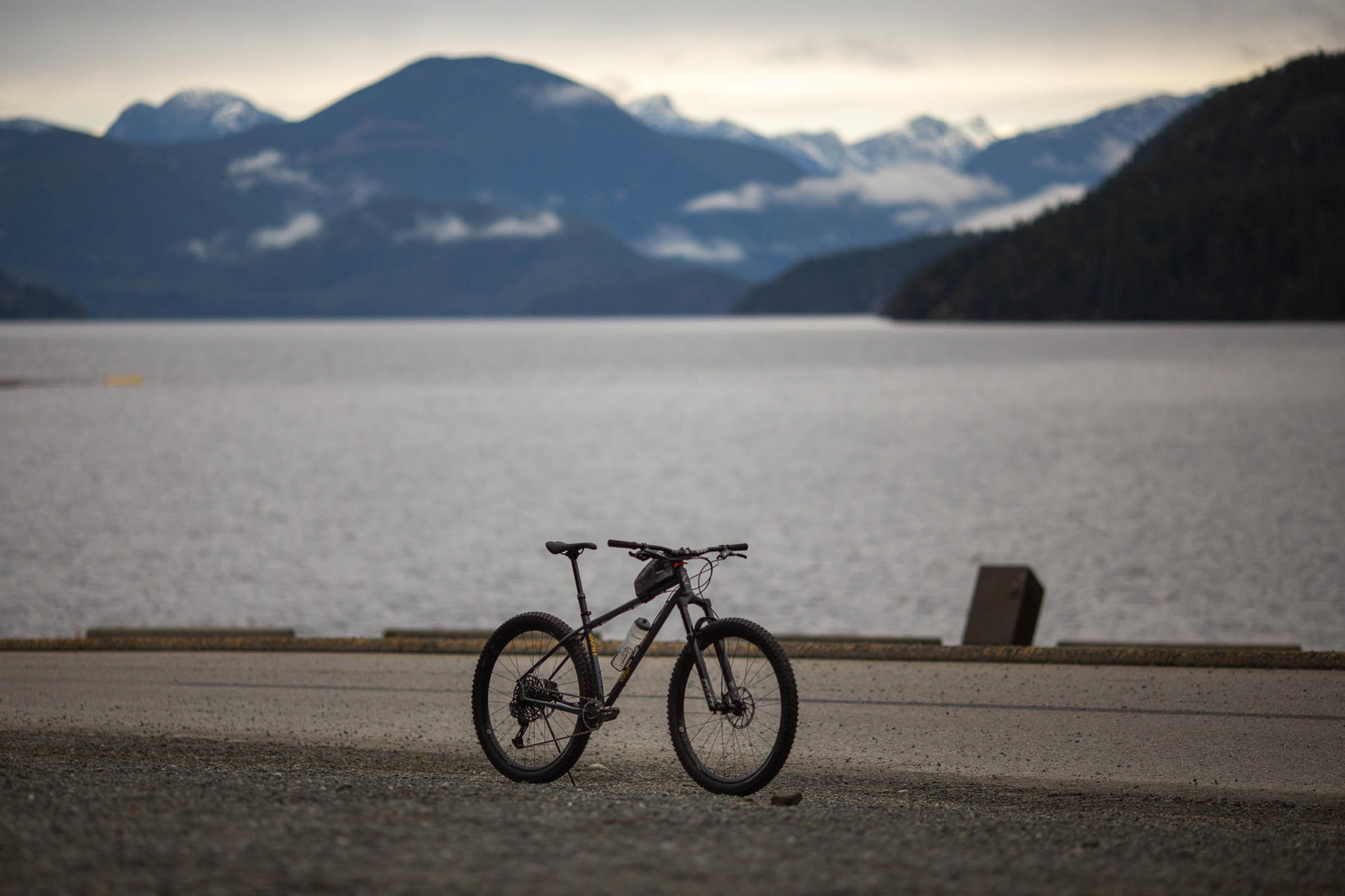
- Size Tested: Large
- Actual Weight: 31 pounds (14kg)
- Place of Manufacture: Taiwan
- Price: $3,300 USD
- Manufacturer’s Details: EskerCycles.com
Pros
- Well-balanced geometry for trail riding and big descents, with an emphasis on big backcountry terrain
- Well-specced build kits offer great bang for the buck. Buy and ride!
- Bikepacking-friendly features that include external cables, adjustable dropouts, and frame bag bosses
- Clean, aesthetically pleasing frame
Cons
- Tight 29 x 2.8″ tire clearance falls short of a true 29+ trail bike
- Minimal frame bag space could be frustrating for those on smaller sizes
- No rear rack mounts
- Heavy
Wrap Up
Despite its unique geometry, it didn’t take long to figure out what the Esker Japhy is best suited for. It’s the bike I wish I’d brought to the South Chilcotin Mountains last summer, where the climbs are mostly wide doubletrack or hike-a-bikes, the descents are long and fast, and everything else is fairly chunky. As someone who enjoys the challenge of technical, slow-speed riding, the Japhy fell a bit short of my expectations, which was heavily influenced by how much time I’ve spent riding my Why S7 over the years. As far as making the transition to a more progressive, modern hardtail, I actually think the Japhy hits a sweet spot between some of the more conservative and radical options currently available. It can handle the chunkiest of terrain and its big 29 x 2.8″ tires roll quickly on gravel, pavement, and nearly any trail.
There’s no question that the Japhy offers a lot of bang for its buck and is incredibly capable. If your perfect day on the bike involves long service road climbs, backcountry singletrack, or rambling down forgotten trails, the Japhy should be near the top of your list. On the other hand, the Hayduke is a little less progressive but arguably better suited for general purpose bikepacking, especially for smaller riders who prefer 27.5 x 2.8” tires and want more frame bag space. In the end, both bikes are dialled for trail riding and singletrack-heavy bikepacking and are shining examples of what modern, steel hardtails should be.
Neil’s Esker Japhy Video Review
Looking for another take on the Japhy? Neil also spent some time riding the Esker Japhy and put together a detailed video review for our YouTube channel. Watch it below.
Please keep the conversation civil, constructive, and inclusive, or your comment will be removed.






